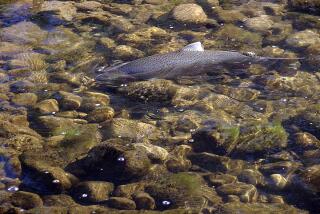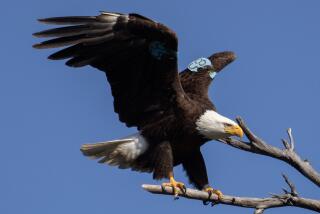First Newborn Bald Eagles in Years Seen in Southland
The first bald eagles believed to be born wild in Southern California since the 1930s have been found in the middle of a shooting range near a popular Riverside County RV park.
The discovery of two eaglets is raising cautious hope among biologists who have seen nesting fail across the region because of lingering DDT pollution and encroaching development.
“This is the first time we’ve been able to prove it, the first time in Southern California that we’ve documented successful nesting. We’re really excited,” said biologist Kevin Brennan of the California Department of Fish and Game.
The striking double find is evidence of the national symbol’s comeback from near extinction in the 1960s.
The shooting range, used in target practice by Lake Hemet Municipal Water District rangers, was closed in March after the nest was spotted halfway up a tall pine. “Keep Out” signs were then posted along a wide buffer. The annual “mountain men days” celebration, complete with musket shooting, was moved.
On Wednesday, state and federal biologists paddled out in a canoe and confirmed what locals thought they had seen: a pair of large, gawky brown eaglets out of the nest, hopping and taking short flights under their majestic parents’ watchful eyes.
“We went out early this morning just past sunrise,” Brennan said. “All of a sudden, just a few yards from us, it was sitting there. I said, ‘Oh my God, it’s a fledgling.’ ” They paddled back to pick up another biologist, and when they returned, they noticed a second eaglet a few feet away.
*
Keeping Fingers Crossed
If the 9-week-old eaglets survive, federal and state wildlife officials say, they will have begun repopulating the southern end of their historical nesting range before bald eagles were all but wiped out in California by coastal development and the manufacture and use of the pesticide DDT.
The farthest south that successful nests have been found in California since recovery efforts began is in central Santa Barbara County, said Ron Jurek, who coordinates bald eagle recovery tracking statewide for the Department of Fish and Game.
The eagles have also successfully bred in the Sierra, said Brad Bortner, chief of the Division of Migratory Birds and Habitat Programs for the Pacific region of the U.S. Fish and Wildlife Service. The bald eagle’s stronghold is now along the salmon-rich northwest coast of North America, with about 70,000 -- half the world’s population -- in Alaska, and 20,000 in British Columbia.
In recent years, as many as two dozen of the snowy-headed raptors have wintered in the Big Bear Lake area. A few pairs have grown so fond of mild Southern California winters that they’ve moved into the area year-round. Juveniles have been spotted on the wing. But this week’s find is the first tangible evidence that a new population may be reestablished in the crowded Southland.
“This is important,” Jurek said. “They were in Southern California historically, and they’re back in Southern California again ... but they’re inland.”
As traditional coastal habitat has been gobbled up by Highway 1 and beachside development, eagles have adapted, Jurek said. They are homing in on inland reservoirs regularly stocked with fish. In fact, the successful nest is not far from an unassuming vacation trailer park along man-made Lake Hemet, about 100 miles southeast of Los Angeles.
Eggs were found in nests near three other Riverside County reservoirs in the early 1990s, but they failed to hatch for a variety of reasons, including immature parents who chose poor nesting sites, crow predation and eggshell thinning from DDT poisoning, Jurek said.
The bald eagle population nationwide was decimated after the pesticide worked its way up the food chain: Bugs ingest the chemical and are eaten by fish, which in turn are eaten by the eagles, which then suffer reproductive problems.
Bald eagles were last recorded successfully nesting in Malibu in 1931 and in Laguna Beach in the 1920s. While never common in Southern California, they did nest along the coast and on the Channel Islands.
DDT was manufactured for years in Torrance. There are still ocean deposits of DDT off Palos Verdes. The pesticide was also used liberally on farms statewide, and ran off into creeks and other water bodies.
Lake Hemet, a 100-year-old reservoir, is in the San Bernardino National Forest. At 4,340 feet elevation, it is fairly high up and may have avoided harmful agricultural runoff. It is also stocked with fish every other Monday.
The adults have become a regular sight at the busy lakeside campground in recent years, thrilling sportfishermen who marvel at their seven-foot wingspan as they soar over the sun-warmed shallows.
“Aren’t they the most gorgeous bird you’ve ever seen? I just love them,” said Arthur Stephens of Royal Oak, Mich., who was born and raised in Santa Ana and has vacationed here since 1962. He and his daughter Erin, 22, had been spotting the eagles all week.
“There’s one right now!” Erin hollered Thursday as one of the parents soared overhead, traversing the lake’s breadth in seconds. The birds can fly up to 50 mph, although typically they sit and watch the water from a high perch.
“I’ve been calling her ‘Eagle Eye’ all week, because she can spot ‘em,” her father said.
U.S. Forest Service biologist Kim Huber, who monitored the nest along with a water district ranger, was worried that the eagles had chosen to nest near “so urbanized a recreation area.” Generators purr loudly in the campground, and dozens of motorboats ply the lake. Then there’s the shooting range. But there are plenty of fish -- trout, bass, catfish, carp and bluegill.
Eagles usually mate for life and will return to the same nest year after year. The nests can eventually weigh as much as a ton, as new branches and other materials are added. Huber said any decision about the shooting range or other human activities is up to federal officials.
*
The Human Interface
Bortner, of the Fish and Wildlife Service, warned that deliberately approaching or disturbing a bald eagle violates three federal laws. He said halting shooting practice during breeding season might be a long-term solution.
Locals said the bald eagles couldn’t have picked a better place than this family-friendly mountain spot, where, just like the eagles, some have vacationed for generations and others have moved in permanently.
“I’m mighty proud of those birds,” said Dusty Dishman, 50, from behind the counter at the Lake Hemet Store (out front, a sign announces “Bait-Jerky-Ice”). “There’s not that many of ‘em around anymore, and we’ve got two nesting right here. Maybe we’ll have bald eagles around when my grandkids’ kids are around.”
More to Read
Start your day right
Sign up for Essential California for news, features and recommendations from the L.A. Times and beyond in your inbox six days a week.
You may occasionally receive promotional content from the Los Angeles Times.






